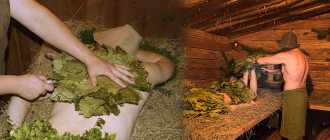From time immemorial, in Russian life and Russian tradition, the bathhouse has always been a sacred and magical place. There a person came into this world, and very often left it, they tried to determine their fate, one of the most evil and insidious house spirits lived there, and finally, a weekly ritual was held there, colloquially called a bath day. The Russian bathhouse is a symbol of the Russian spirit and way of life, in our story today.
Legends of deep antiquity
No one can say for sure when baths appeared in Rus'. Even in the pre-Christian era, they were a formed and independent product with their own culture and even traditions. Mentions of them can be found during the conquest of Constantinople by the Kyiv squad led by Prince Oleg from the Rurik family. Even then, the Russian steam bath was fundamentally different from its Byzantine relatives, who, in turn, were greatly influenced by Roman baths.
In fairness, it must be said that the bathing traditions of the Roman Empire were a classic reference product that used the most advanced technological achievements of that time for its arrangement. Even after the fall of the Western Roman Empire under the blows of the barbarians, its eastern part continued to profess and use existing developments in the field of hygiene and organization of bathing leisure.
But even such achievements, such chic and brilliance, which were inherent in Roman baths, did not in any way impress our ancestors, who, even in Byzantium, reserved for themselves the right to practice exclusively the Slavic bath rite. There is mention of our bathhouse in the classic written monument - “The Tale of Bygone Years”; sayings about the Russian bathhouse are attributed to Andrew the First-Called himself. European guests of our region, since the time of Peter and Catherine, also left their testimonies about our bathhouse. A product that is colorful, original and unforgettable.
How it all began: the history of the Russian bathhouse
The Russian bathhouse is one of the most ancient; some historians believe that its appearance almost coincides in time with the very emergence of the Slavs as an ethnic community. Since ancient times, it was believed that the bathhouse combines the four main natural elements: water, fire, air and earth. According to the ideas of the ancient Slavs, by visiting a bathhouse, a person absorbs the power of these elements and becomes stronger in both body and spirit. Our distant ancestors firmly believed in the cleansing and healing power of baths; it was customary to take a steam bath before making important decisions and after a long journey. Over time, the offer to visit the heated bathhouse became a hallmark of Russian hospitality.
The Russian bathhouse was very popular among all social strata: both the aristocracy and the common people took steam in the bathhouse. Anyone who had enough land for this could build a bathhouse. In the middle of the 17th century, a decree was issued allowing the construction of baths only at a distance from residential buildings; Most likely, the reason for this rule was fire safety considerations. Gradually, along with private baths, public baths began to appear, where anyone could take a steam bath for a certain fee. The most famous Russian baths can rightfully be called the Sandunovsky baths, founded in 1808 and functioning to this day.
More banyas - good and different
Initially, at an early stage, the principle of heating a bathhouse in black was laid down. What it consisted of:
- The bathhouse was as compact as possible and consisted, as a rule, of one internal volume - a steam room;
- The sauna log house was very often buried in the ground to increase the level of thermal insulation of the walls, which was extremely important in the harsh conditions of the Russian North;
- There was a stone hearth in the middle of the interior; wood was used as fuel. Smoke freely emanated from the firebox into the room and, washing the walls and ceiling, escaped into the atmosphere through openings in the walls and roof. Some of the smoke escaped through the slightly open door;
- The entrance to the bathhouse, or rather the doorway, had a very high threshold, which prevented the entry of cold air from the street due to the absence of an intermediate room - a dressing room;
- The absence of a dressing room also forced the construction of a canopy over the entrance to the bathhouse to store a certain supply of firewood and clothing;
- The atmosphere and surfaces of the interior were saturated with phytoncides, especially when burning birch firewood with birch bark;
- The smoke removal system, or rather its absence, forced a pause between heating the fireplace and the start of procedures for the flow of carbon monoxide - an inevitable companion to fuel combustion, especially in conditions of lack of oxygen;
- The black sauna provided for preliminary cleaning and rinsing of the shelf from soot and other combustion products, and “releasing the first steam” of high intensity, for guaranteed smoke removal and final degassing. As in Vysotsky’s words: “I’ll get mad and I’ll go crazy…” there’s no need to get mad. It is necessary to prepare the black sauna well for the park.
There are many examples of such primitive baths preserved in ethnographic museums; a particularly interesting example is carefully preserved in Kizhi. In addition, in the northern outback such baths are still in use and not without success. The reasons are trivial - extreme simplicity of construction, high energy efficiency and fuel efficiency. Moreover, in the wake of increasing interest in national traditions, the reincarnation of the Russian black bath is noted, even in the conditions of the modern world and the achievements of progress. The main factor here is the special healing atmosphere of such a steam room, which, according to experts, is unattainable by other heating methods.
White bath - stability, means quality
A peculiar antagonist of the black bath is a bath heated in white. As a rule, the structure is more capital and much more spacious. There is a dressing room, a heating room, and the stove itself is, in some way, a work of art. A heater stove, depending on the type of stove and the material from which it is made, is either solid or flow-through. Visiting such a bathhouse has become a kind of ritual. The presence of a warm and dry dressing room simply requires a number of related procedures. From massage and honey wraps to drinking tea and healing infusions.
The bathhouse gradually turned into a kind of club and place for leisure activities. Moreover, well-equipped with high-quality steam, wood-burning spirit and a cozy atmosphere has become a classic commercial product - a source of income. The apogee of the commercial trend in the environment was the legendary Moscow Sandunovskie baths, the name of which has long become a household name.
Wood as the basis of the Russian bath tradition
A Russian bathhouse cannot be imagined without a wooden frame, a linden tub, oak firewood, alder benches and a birch broom. Wood gives life and is an indispensable attribute of its successful functioning.
The construction of a Russian bathhouse is simply unthinkable without wood. And wood has such an important indicator as thermal conductivity. Let's look at it by comparing different types:
| Type of commercial wood | Thermal conductivity index |
| Oak | 200-400 |
| Birch | 150 |
| Siberian cedar | 95 |
| Norway spruce | 110 |
| Siberian larch | 130 |
| Norway maple | 195 |
| Fir | 150 |
| Linden | 150 |
| Scots pine | 150-400 |
| Poplar | 170 |
| Cork tree | 45 |
Attention! The specified parameters for calculating the thermal conductivity coefficient are valid at an outdoor temperature of −30 degrees C, indoor temperature +40 degrees C. For oak and pine, the first value is sawing commercial wood across the grain, the second - along.
Thus, cedar and spruce in northern conditions provided acceptable parameters for heat retention in such a room, which fully justifies their use both in ancient times and in modern conditions.
It is also worth looking at the properties of other types of wood that were traditionally used in the construction of a Russian bath:
- Oak is a strong, durable material with a unique spicy aroma and beautiful texture, which acquires a noble shade over time. Commercial oak timber is expensive, the logs are heavy and, moreover, very difficult to process;
- Larch is close to oak in its physical qualities and durability, but is somewhat cheaper. It has a rich and original wood color that lasts for years. Saturated with resinous inclusions that have a pronounced phytoncidal character;
- Cedar continues the line of noble conifers, along with larch. Cedar lining is not a cheap pleasure, but it has a very beautiful, and in some ways even picturesque, texture. Resistant to pests and fungi. Inherently low coefficient of thermal linear expansion. Rich in resins, which, however, easily sublimate and deactivate under conditions of high temperatures and humidity;
- The golden mean in finishing the structure of a Russian steam room, in terms of price and quality ratio, is linden. It is easy and predictable to process, fairly durable, and has a soft, unobtrusive coloring of solid wood. It is fragrant, and the aroma is healing for people with respiratory problems. Solid linden wood is not prone to cracking;
- Alder is the queen of the steam room. The use of its wood guarantees a comfortable stay on the shelves, due to the exclusion of skin burns. The aroma of alder is long-lasting and, due to the fermentation of the resins, becomes even more pleasant over time. As the old bath attendants say, “red alder is ripening”;
- Birch in a steam room is exceptionally good only in the form of brooms. Possessing a dense and uniform structure, its wood is short-lived in conditions of high humidity. If the bathhouse is exclusively dry-air, like an Irish one, then it’s a good option. But in the context of our topic, it’s still not relevant;
- Aspen, pine and spruce are the most affordable options for interior decoration. However, aspen should be used only in dry parts of the bathhouse, for example in the dressing room, and should also be well protected, while conifers do not tolerate direct contact with moisture and abundantly secrete resin, which is saturated with heavy, low-volatile components.
A word from Experienced! It must be said that these types of wood and more can be used in accordance with their properties. And for the manufacture of bath utensils and bath items and other things. In general, bathhouses in Rus' do not know any bad or useless trees.
Baths of the ancient Romans. Architectural delights
In ancient Rome, the bathhouse was simply stunningly popular. The bathhouse entered the life of the Romans long ago and forever! Roman rulers spent enormous amounts of money on the construction of baths. The most expensive building materials for interior decoration were brought from all over the world. Architects spared no effort in creating rich interiors: golden sculptures, hanging gardens, all kinds of waterfalls and fountains decorated the facades of Roman baths. Technically, Roman baths were equipped much more advanced than in other countries of the Ancient World. There were water pipes, drains and even heating. An unimaginable amount of water was spent per day to maintain the bathhouse for those times - about a million liters of water! In the baths, the inhabitants of Rome not only performed ablution rituals, but also gathered in communities based on interests and hobbies: they read poetry, sang songs, had dinner, and painted. The baths also had areas for healing procedures. Wealthier residents of Rome could enjoy visiting the bathhouse several times a day.
Top secret
The first to notice the healing properties that the bath has on the human body were the Magi - the most advanced and educated part of the then pre-Christian society. It was they who began to practice the use of two key natural elements, fire and water, and additional ones - medicinal herbs, in their medical practice.
Moreover, there is reason to believe that already at that time such a thing as a physiological clock was known - a certain cycle of occurrence, activation or, conversely, attenuation of basic physiological processes. Unfortunately, the lion's share of the knowledge of that time was irretrievably lost, along with the departure from the historical scene of the pagan religion and its bearers. The basis of the pagan world was maximum unity with nature.
Therefore, the Russian-style bathhouse was performed with maximum use of the gifts of nature. The place was chosen near a water source, logs were provided by the forest, a stone for the heater was provided by a cliff on the river bank, even the cracks between the logs and beds were filled with a mixture of soaked forest moss and resin - the resin of coniferous trees.
Traditions provide for the widespread use of medicinal herbs and roots. The most common ones should be mentioned separately:
- Mint is a well-deserved and revered spicy plant with an excellent mild aroma and excellent properties by all bathhouse attendants. Calms the nervous system and stimulates brain activity. In the pagan era, hunters of large animals, primarily bears, enjoyed the mint aroma in the bathhouse. Modern scientists associate this fact with some suppression of the activity of the human central nervous system, as a result of which all the actions of the hunting party were distinguished by thoroughness and prudence. Excessive nervousness and fuss are bad helpers in such a matter;
- St. John's wort - when a decoction of this herb was added to the hot stones of the stove, a very good herbal background was created. St. John's wort itself does not have a dominant, pronounced aroma, but the abundance of essential oils makes it an indispensable inhaler in the treatment of the upper respiratory tract, and simply as a preventive measure for such diseases;
- Chamomile - unlike mint, was used as a relaxing and tonic. It was chamomile decoction that was the first remedy in the bathhouse for a walker or traveler before they set off on a long journey. The abundance of microelements and muscle fiber stimulants in the aqueous extract of this herb helped to better and more functionally endure monotonous physical activity, primarily associated with endurance indicators. Experts in Volga life claim that the most enduring gangs of barge haulers were from Nizhny Novgorod. They say the workers there knew a centuries-old recipe for a herbal bath infusion, which included elecampane, chamomile, and oregano. The complete recipe has been lost, but enthusiasts are trying to restore it. After all, a bath taken with such a drug guaranteed high-quality work for an average barge hauler for 12-14 days. Exactly until the next bath;
- Horseradish - a ladle of infusion of the root poured onto a heater, drove out any, even the most chronic cold from the body. It also suppressed rheumatoid pain, not without success. True, the principle of application was somewhat different. A birch broom was pre-soaked in the infusion.
The main tool of the bath industry
Popular wisdom says: “A bathhouse without a broom is like a rocker without a bucket.” Well, how? Right. It seems like everything is there, but there’s no point. Going to the bathhouse and not getting your share of a kind of scorching massage is akin to a crime. The secrets of the Russian bathhouse, which so excited the minds of Europeans, are inseparable from the broom, a seemingly simple, outrageously tool, but what an effective one. The Russian bathhouse always rested on three different brooms, like on three whales.
- Oak broom is good for oily, thick skin. It cleanses it perfectly, relieves inflammation, opens pores;
- Birch - indispensable for muscle inflammation, myositis, rheumatoid conditions;
- Juniper - has perhaps the most pronounced antibactericidal properties. It comes in handy for various colds.
A Russian bathhouse is not only a steam room, but also post-bath exercise, usually in the dressing room.
Bath in Egyptian culture. Healing procedures
According to excavations, in ancient Egypt, baths were two-story structures. On the first floor there was a steam room, on the second there were stone beds with holes through which steam passed from below. The Egyptians attached great importance to the cleanliness of their bodies, they washed in baths four times a day and used beeswax as soap. Therefore, baths were located everywhere and were accessible to everyone. But it was not only personal hygiene that forced the inhabitants of this ancient country to visit the bathhouse. The Egyptians used this place for many healing procedures: they did inhalations, various massages and even gymnastics. The love of baths, physical exercise, and moderation in food allowed the Egyptians to stay in shape for a long time and not grow old. Egyptian doctors of that period of time were highly valued; they successfully used water and hot steam, otherwise known as baths, in treating their patients.
Tea, kvass, beer and excesses are bad
As is well known, in a steam room there is an active loss of moisture from the human body, and since the human body itself consists of 80% water, the losses must be restored.
The best option is herbal tea. It is herbal tea, since Indian, Ceylon and other overseas teas, in company with domestic tea - Krasnodar tea, provokes activation of the heart rate, which is useless in the relaxing atmosphere of a cool dressing room. In addition, the heart already worked actively in conditions of high temperatures. Linden tea, tea with oregano and thyme herbs are wonderful.
Classic village bread kvass quenches your thirst well. When baths appeared in Rus', this wonderful drink appeared around the same time. Bread kvass is rich in microelements, B vitamins, enzymes, which, in turn, are rich in one of its main components - grain malt.
Beer. Well, what is a Russian bath without this intoxicating, fragrant, foamy drink. When consumed in moderation, beer can provide some benefits, or at least not cause a devastating blow to your health. Excessive use is harmful. It is clear that everyone has their own norm, but practical and pedantic Germans calculated that a liter beer mug is the ceiling norm for a person of average build.
The whole truth about the Russian bath cannot fit into the volume of one article; it is a huge, interesting, original and practically inexhaustible topic. Many interesting facts were left outside the scope of this essentially review material. It is impossible to tell everything. But we will try very hard.










